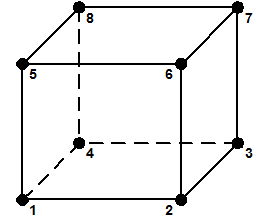BbarBrick u-p Element: Difference between revisions
(Created page with '{{SoilEleModelsUserManualMenu}} '''bbarBrickUP''' is a 8-node mixed volume/pressure element, which uses a tri-linear isoparametric formulation. Each node has 4 degrees-of-freed...') |
No edit summary |
||
| Line 1: | Line 1: | ||
{{ | {{CommandManualMenu}} | ||
'''bbarBrickUP''' is a 8-node mixed volume/pressure element, which uses a tri-linear isoparametric formulation. | '''bbarBrickUP''' is a 8-node mixed volume/pressure element, which uses a tri-linear isoparametric formulation. | ||
| Line 6: | Line 6: | ||
This element is implemented for simulating dynamic response of solid-fluid fully coupled material, based on Biot's theory of porous medium. | This element is implemented for simulating dynamic response of solid-fluid fully coupled material, based on Biot's theory of porous medium. | ||
'''Please''' [ | '''Please''' [http://quakesim.net/index.php?title=Examples click here] '''for examples.''' | ||
| Line 62: | Line 62: | ||
Return to: | Return to: | ||
*[[Element Command]] | |||
**u-p Elements | |||
**[[Four Node Quad u-p Element]] | |||
**[[Brick u-p Element]] | |||
**[[Brick Large Displacement u-p Element]] | |||
**[[bbarQuad u-p Element]] | |||
**[[bbarBrick u-p Element]] | |||
**[[Twenty Node Brick u-p Element]] | |||
**[[Nine Four Node Quad u-p Element]] | |||
**[[Twenty Eight Node Brick u-p Element]] | |||
**[[SSPquadUP Element]] | |||
**[[SSPbrickUP Element]] | |||
Revision as of 17:23, 7 August 2012
- Command_Manual
- Tcl Commands
- Modeling_Commands
- model
- uniaxialMaterial
- ndMaterial
- frictionModel
- section
- geometricTransf
- element
- node
- sp commands
- mp commands
- timeSeries
- pattern
- mass
- block commands
- region
- rayleigh
- Analysis Commands
- Output Commands
- Misc Commands
- DataBase Commands
bbarBrickUP is a 8-node mixed volume/pressure element, which uses a tri-linear isoparametric formulation.
Each node has 4 degrees-of-freedom (DOF): DOFs 1 to 3 for solid displacement (u) and DOF 4 for fluid pressure (p). This element is implemented for simulating dynamic response of solid-fluid fully coupled material, based on Biot's theory of porous medium.
Please click here for examples.
OUTPUT INTERFACE:
Pore pressure can be recorded at an element node using OpenSees Node Recorder:
recorder Node <-file $fileName> <-time> <-node ($nod1 $nod2 …)> -dof 3 vel
See OpenSees command manual (McKenna and Fenves 2001) for nodal displacement, velocity, or acceleration recorders.
The valid queries to a bbarBrickUP element when creating an ElementRecorder are 'force', 'stiffness', or 'material matNum matArg1 matArg2 ...', where matNum represents the material object at the corresponding integration point.
| element bbarBrickUP $eleTag $Node1 $Node2 $Node3 $Node4 $Node5 $Node6 $Node7 $Node8 $matTag $bulk $fmass $PermX $PermY $PermZ <$bX=0 $bY=0 $bZ=0> |
| $eleTag | A positive integer uniquely identifying the element among all elements |
| $Node1,… $Node8 | Eight element node (previously defined) numbers (see figure above for order of numbering). |
| $matTag | Tag of an NDMaterial object (previously defined) of which the element is composed |
| $bulk | Combined undrained bulk modulus Bc relating changes in pore pressure and volumetric strain, may be approximated by:
Bc ≈ Bf/n where Bf is the bulk modulus of fluid phase (2.2x106 kPa (or 3.191x105 psi) for water), and n the initial porosity. |
| $fmass | Fluid mass density |
| $permX, $permY, $permZ | Permeability coefficients in x, y, and z directions respectively. |
| $bX, $bY, $bZ | Optional gravity acceleration components in x, y, and z directions directions respectively (defaults are 0.0) |
Return to:
